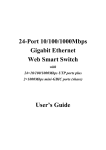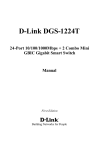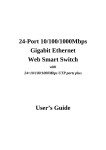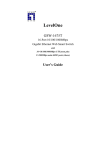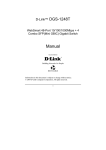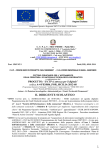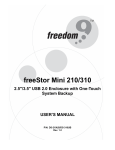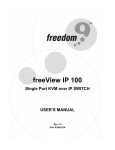Download Freedom9 2420 Switch User Manual
Transcript
freeConnect Smart 2420 24-Port 10/100Mbps + 2-Port Combo-SFP Web Smart Switch USER’S MANUAL P/N: S102411200 Rev. 1.0 Copyright and Trademark Information Freedom9 makes no warranty or representation, expressed or implied, with respect to the contents or use of this documentation. Freedom9 reserves the right to modify this documentation at any time without obligation to notify any individual or entity of such modifications. © Copyright 2006, freeConnect Smart and the freedom9 company logo are trademarks or registered trademarks of Freedom9 Inc. All rights reserved. No part of this document may be photocopied, reproduced, or translated into another language without express prior to written consent of Freedom9 Inc. Windows is a trademark or registered trademark of Microsoft Corporation. Other trademarks or registered trademarks are the property of their respective holders. TABLE OF CONTENTS 1 ABOUT THIS GUIDE........................................................................................................................... 1 1.1 1.2 2 INTRODUCTION ................................................................................................................................. 2 2.1 2.2 2.3 2.4 3 FRONT PANEL ................................................................................................................................. 6 REAR PANEL .................................................................................................................................. 6 UNDERSTANDING LED INDICATORS .............................................................................................. 8 5.1 5.2 5.3 6 UNPACKING .................................................................................................................................... 4 INSTALLATION ................................................................................................................................. 4 RACK MOUNTING ............................................................................................................................ 4 CONNECTING NETWORK CABLE ....................................................................................................... 5 AC POWER .................................................................................................................................... 5 IDENTIFYING EXTERNAL COMPONENTS....................................................................................... 6 4.1 4.2 5 GIGABIT ETHERNET TECHNOLOGY ................................................................................................... 2 FAST ETHERNET TECHNOLOGY ........................................................................................................ 2 VLAN (VIRTUAL LOCAL AREA NETWORK)......................................................................................... 2 FEATURES ...................................................................................................................................... 3 UNPACKING AND INSTALLATION.................................................................................................... 4 3.1 3.2 3.3 3.4 3.5 4 PURPOSE ....................................................................................................................................... 1 TERMS/USAGE ............................................................................................................................... 1 POWER AND SYSTEM LEDS ............................................................................................................ 8 PORTS 1~24 STATUS LEDS ............................................................................................................ 8 PORTS 25~26 STATUS LEDS .......................................................................................................... 8 CONFIGURATION............................................................................................................................. 10 6.1 6.2 6.3 6.4 6.5 6.6 6.7 6.8 6.9 6.10 6.11 INSTALLING THE WEB MANAGEMENT UTILITY .................................................................................. 10 DISCOVERY LIST ........................................................................................................................... 10 MONITOR LIST ...............................................................................................................................11 DEVICE SETTING .......................................................................................................................... 12 TOOLBAR ..................................................................................................................................... 13 CONFIGURING THE SWITCH ........................................................................................................... 14 LOGIN .......................................................................................................................................... 14 MAIN MENU .................................................................................................................................. 16 CONFIGURING SETUP SETTING ...................................................................................................... 16 MAINTENANCE SETTINGS .............................................................................................................. 21 LOGOUT ....................................................................................................................................... 23 7 TECHNICAL SPECIFICATIONS ....................................................................................................... 24 8 CERTIFICATIONS ............................................................................................................................. 25 freeConnect Smart 2420 User’s Manual 1 About This Guide Thank you for purchasing the freeConnect Smart 2420. This device integrates 1000Mbps Gigabit Ethernet, 100Mbps Fast Ethernet and 10Mbps Ethernet network capabilities in a highly flexible package. 1.1 Purpose This guide discusses how to install your freeConnect Smart 2420. 1.2 Terms/Usage In this guide, the term “Switch” (first letter upper case) refers to your freeConnect Smart 2420, and “switch” (first letter lower case) refers to Ethernet switches in general. 1 2 Introduction This chapter describes the features of the freeConnect Smart 2420 and some background information about Ethernet/Fast Ethernet/Gigabit Ethernet switching technology. 2.1 Gigabit Ethernet Technology Gigabit Ethernet is an extension of IEEE 802.3 Ethernet utilizing the same packet structure, format, and support for CSMA/CD protocol, full duplex, flow control, and management objects, but with a tenfold increase in theoretical throughput over 100-Mbps Fast Ethernet and a hundredfold increase over 10-Mbps Ethernet. Since it is compatible with all 10-Mbps and 100-Mbps Ethernet environments, Gigabit Ethernet provides a straightforward upgrade without wasting a company’s existing investment in hardware, software, and trained personnel. The increased speed and extra bandwidth offered by Gigabit Ethernet is essential to coping with the network bottlenecks that frequently develop as computers and their busses get faster and more users use applications that generate more traffic. Upgrading key components, such as your backbone and servers to Gigabit Ethernet can greatly improve network response times as well as significantly speed up the traffic between your subnets. Gigabit Ethernet enables fast optical fiber connections to support video conferencing, complex imaging, and similar data-intensive applications. Likewise, since data transfers occur 10 times faster than Fast Ethernet, servers outfitted with Gigabit Ethernet NIC’s are able to perform 10 times the number of operations in the same amount of time. In addition, the phenomenal bandwidth delivered by Gigabit Ethernet is the most cost-effective method to take advantage of today’s and tomorrow’s rapidly improving switching and routing internetworking technologies. 2.2 Fast Ethernet Technology The growing importance of LANs and the increasing complexity of desktop computing applications are fueling the need for high performance networks. A number of high-speed LAN technologies have been proposed to provide greater bandwidth and improve client/server response times. Among them, 100BASE-T (Fast Ethernet) provides a non-disruptive, smooth evolution from the current 10BASE-T technology. The non-disruptive and smooth evolution nature, and the large installed market base, virtually guarantees cost-effective and high performance Fast Ethernet solutions. 100Mbps Fast Ethernet is a standard specified by the IEEE 802.3 LAN committee. It is an extension of the 10Mbps Ethernet standard with the ability to transmit and receive data at 100Mbps, while maintaining the CSMA/CD Ethernet protocol. Since the 100Mbps Fast Ethernet is compatible with all other 10Mbps Ethernet environments, it provides a straightforward upgrade and takes advantage of the existing investment in hardware, software, and personnel training. 2.3 VLAN (Virtual Local Area Network) A VLAN is a group of end-stations that are not constrained by their physical location and can communicate as if a common broadcast domain, a LAN. The primary utility of using VLAN is to reduce latency and need for routers, using faster switching instead. Other VLAN uses include: Security: Security is increased with the reduction of opportunity in eavesdropping on a broadcast network because data will be switched to only the users within the same VLAN. freeConnect Smart 2420 User’s Manual Cost Reduction: VLANs can be used to create multiple broadcast domains, thus eliminating the need of expensive routers. Port-based (or port-group) VLAN is the common method of implementing a VLAN, and is the one supplied in the Switch. 2.4 Features • 24x10/100Mbps Auto-negotiation Fast Ethernet ports • 2x10/100/1000Mbps Auto-negotiation Gigabit Ethernet ports • 2xmini-GBIC (shared with two Gigabit Ethernet ports) • All RJ45 ports support auto MDI/MDIX, so there is no need to use cross-over cables or an up-link port • Half duplex transfer mode for connection speed 10Mbps and 100Mbps • Full duplex transfer mode for connection speed of 10Mbps, 100Mbps and 1000Mbsps • Wire speed reception and transmission • Store-and-Forward switching scheme capability to support rate adaptation and ensure data integrity • Up to 8k unicast addresses entities per device, self-learning, and table aging • 2Mbits packet buffer • Supports IEEE 802.3x flow control for full-duplex mode ports • Supports Port-based VLAN • Supports Port-based QoS / IEEE 802.1P based QoS • Supports Port-based Trunking • Supports Port-Mirroring • Supports Port-setting for Speed/Disable, Flow control • Easy configuration via Web Browser • Easy setting via Web Management Utility • Standard 19” Rack-mount size 3 3 Unpacking and Installation This chapter provides unpacking and installation information for the Switch. 3.1 Unpacking Open the box and carefully unpacks its contents. The box should contain the following items: • One freeConnect Smart 2420 • One AC power cord, suitable for your area’s electrical power connections • Four rubber feet to be used for shock cushioning • Screws and two mounting brackets • CD-ROM with Web Management Utility and User’s Guide If any item is found missing or damaged, please contact your local reseller for replacement. 3.2 Installation The site where you install the hub stack may greatly affect its performance. When installing the unit, consider the following pointers: • Install the Switch in a fairly cool and dry place. See Technical Specifications for the acceptable temperature and humidity operating ranges. • Install the Switch in a site free from strong electromagnetic field generators (such as motors), vibration, dust, and direct exposure to sunlight. • Leave at least 4” (10cm) of space at the front and rear of the Switch for ventilation. • Install the Switch on a sturdy, level surface that can support its weight, or in an EIA standard-size equipment rack. For information on rack installation, see the next section, Rack Mounting. • When installing the Switch on a level surface, attach the rubber feet to the bottom of each device. The rubber feet cushion the Switch and protect the case and surface from scratching. 3.3 Rack Mounting The Switch can be mounted in an EIA standard-size, 19-inch rack, which can be placed in a wiring closet with other equipment. Attach the mounting brackets to the switch’s front panel (one on each side), and secure them with the screws provided (Figure 1). Figure 1: Attach the brackets to the Switch Then, use the screws provided with the rack to mount each switch in the rack (Figure 2). freeConnect Smart 2420 User’s Manual Figure 2: Mount the Switch in the rack 3.4 Connecting Network Cable The Switch supports 1000Mbs Gigabit Ethernet that runs in Auto-negotiation mode and 10Mbps Ethernet or 100Mbps Fast Ethernet that runs both in half and full duplex mode and 1000Mbps Gigabit Ethernet runs in full duplex mode using four pair of Category 5 Cable (Category 5e Cable or better is required for Gigabit Ethernet). These RJ-45 ports support Auto-MDIX meaning that the Switch can automatically switch between MDI-II and MDI-X types, allowing you to use any cable without worrying about whether it is a straightthrough or crossover RJ-45 cable. 3.5 AC Power The Switch uses an AC power supply operating at 100-240V AC, 50-60 Hz. The power switch is located at the rear of the unit adjacent to the AC power connector and the system fan. The switch’s power supply will adjust to the local power source automatically and the unit can be turned on any number of Ethernet cable connected to it. 5 4 Identifying External Components This chapter describes the front panel, rear panel, and LED indicators of the Switch. 4.1 Front Panel The figure below (Figure 3) shows the front panels of the Switch. Figure 3: Front panel of the Switch LED Indicator: Comprehensive LED indicators display the status of the switch and the network (see the LED Indicators section below). Fast Ethernet Ports (Port 1~24): These ports support network speeds of 10Mbps and 100Mbps, and can operate in half- and full-duplex transfer modes. These ports also support automatic MDI/MDIX crossover functionality providing true “plug and play” capability. You only have to a device to the switch using a straight-through cable, regardless of whether the device is a computer, switch and hub. Gigabit Ethernet Ports (Port 25~26): The Switch is equipped with two Gigabit twisted pair ports, supported auto negotiable 10/100/1000Mbps and auto MDI/MDIX crossover detection function. These two ports can operate in half-duplex mode for 10/100Mbps and full-duplex mode for 10/100/1000Mbps. Mini-GBIC Ports (Port 25~26): The Switch is equipped with two mini-GBIC ports, supporting standard fiber mini-GBIC modules. These ports use the same ports as the gigabit Ethernet ports. When a mini-GBIC module is plugged into the switch, the corresponding gigabit Ethernet port will be disabled. 4.2 Rear Panel Figure 4: Rear panel of the Switch AC Power Connector: This is a three-pronged connector that supports the power cord. Plug in the female connector of the provided power cord into this connector, and the male into a power outlet. Supported input voltage range is 100-240V AC at 50-60Hz. freeConnect Smart 2420 User’s Manual Reset: The Reset button is used to reset all of the settings back to the factory default. Note: Be sure that you record the settings of your Switch before performing a reset, as all settings will be erased after pressing the “Reset” button. 7 5 Understanding LED Indicators The front panel LEDs provides instant status feedback and helps monitor and troubleshoot when needed (Figure 5). Figure 5: LED indicators of the Switch 5.1 Power and System LEDs Power: Power Indicator On: The Switch is receiving power. Off: The Switch is not receiving power or the power cord has an improper connection. System: CPU Indicator Flashing: The CPU is working. On: The CPU is idling. Off: The unit is off. 5.2 Ports 1~24 Status LEDs Link/ACT: Link/Activity On: The port is successfully connected to an Ethernet network. Flashing: The port is transmitting or receiving data. Off: The port is disconnected. 100Mbps On: The port is connected to a 100Mbps Ethernet connection. Off: The port is connected to a 10Mbps Ethernet connection or is disconnected. 5.3 Ports 25~26 Status LEDs Link/ACT: Link/Activity On: The port is successfully connected to an Ethernet network. Flashing: The port is transmitting or receiving data. Off: The port is disconnected. freeConnect Smart 2420 User’s Manual 1000Mbp On: The port is connected to a gigabit Ethernet connection. Off: The port is connected to a 10Mbps or 100Mbps Ethernet connection or is disconnected. 100Mbps On: The port is connected to a 100Mbps Ethernet connection. Off: The port is connected to a 10Mbps or 1000Mbps Ethernet connection or is disconnected. 9 6 Configuration You can configure features such as VLANs, trunking, and QoS using the Switch’s web interface. With the provided Web Management Utility, you can easily discover all the Web Smart Switches on your network, assign IP addresses to them, change the admin password, and upgrade the firmware. 6.1 Installing the Web Management Utility The following gives instructions guiding you through the installation of the Web Management utility. 1. Insert the Utility CD in the CD-ROM Drive. 1. From the Start Menu on the Windows desktop, choose “Run…” 2. In the “Run…” dialog box, type D:\setup.exe (Where “D:\” is the drive letter of your CD-ROM drive) and click “OK”. 3. Follow the on-screen instructions to install the utility. 4. Upon completion, go to Program Files Æ Web Management_Utility and run the Web Management Utility. (Figure 6). Figure 6: Web Management Utility The Web Management Utility is divided into four parts: Discovery List, Monitor List, Device Setting and Toolbar. The sections below provide details for each section. 6.2 Discovery List This window displays the list of recognized Web Smart switches that are connected to the network. Click the “Discovery” button to begin searching for Switches on the network. This process may take some time, depending on your network configuration. Once the Switches have been discovered, double-click on an entry, or select a switch and click the “Add to monitor list” button to move a Switch from the Discovery List to the Monitor List. Column Heading Definitions: • MAC Address: The Switch’s MAC Address. • IP Address: The current IP address of the device. freeConnect Smart 2420 User’s Manual • Protocol version: The version of the Utility protocol. • Product Name: The Switch’s product name. • System Name: The appointed device system name. • Location: Where the device is located. • Trap IP: The IP where Traps are to be sent. • Subnet Mask: The Subnet Mask of the device. • Gateway: The Gateway of the device. 6.3 Monitor List To monitor a Switch, it needs to be added to the Monitor List. You will be able to manage and view trap events for the Switches in this list. System word definitions in the Monitor List: • S: The status of the Switch; an icon ( not accessible. • IP Address: The current IP address of the device. • MAC Address: The Switch’s MAC Address. • Protocol version: The version of the Utility protocol. • Product Name: The Switch’s product name. • System Name: The appointed device system name. • Location: Where the device is located. • Trap IP: The IP where Traps are to be sent. • Subnet Mask: The Subnet Mask of the device. • Gateway: The Gateway of the device. ) before the switch name indicates that the switch is off or View Trap: The View Trap function allows you to view events that occur on the Switch. The icon beside the “View Trap” button indicates if there is a new trap that has not been viewed yet. When the icon is green, there are no new traps available. When the icon is red, there are new traps waiting to be viewed (Figure 7). Figure 7: Trap Indicator When the “View Trap” button is clicked, a Trap Information window will appear showing the trap information including the Time, Device IP and the Event that occurred (Figure 8). The symbol “ ” represents traps that have not been viewed yet. This symbol will disappear after you review and click on the event record. 11 Figure 8: Trap Information Note: In order to receive Trap information, the Switch has to be configured with the proper Trap IP and Trap Events in the Web browser, which are available in the Trap Setting Menu. Refer to the appropriate section for details. Add Item: Allows you to add a Switch to the Monitor List manually by entering the IP Address of the device that you want to monitor. Delete Item: Allows you to delete the Switch from the Monitor List. 6.4 Device Setting You can configure the Switch by using the buttons in the Device Setting section at the bottom of the window. Configuration Setting: From this window, you can set the IP Address, Subnet Mask, Gateway, Set Trap to (Trap IP Address), System Name and Location of the Switch. Select the device in the Discovery list or Monitor List and click “Configuration Setting”. The Configuration Setting window will open (Figure 9). After making the desired changes, you enter the password for the Switch and click “Set” to save the changes to the Switch. Figure 9: Configuration Setting Window Password Change: This option allows you to change the password for the Switch. After clicking the button to open the Change Password Window (Figure 10), enter the new password in both the “New password” field and “Confirm password” field. You also have to enter the current password for the Switch in the “Original password” field. Click “Set” to save the changes. freeConnect Smart 2420 User’s Manual Figure 10: Password Change Firmware Upgrade: If a new firmware becomes available, use this option to perform a firmware upgrade on the device (Figure 11). You will need to enter the location of the file on the local computer, as well as the password for the Switch in order to perform an upgrade. Warning: Do not turn off the Switch or the computer while a firmware upgrade is in process, it may result in corruption of the firmware on the Switch. Figure 11: Firmware Upgrade Web Access: Double click on a Switch in the Monitor List, or select a device in the Monitor List and click the “Web Access” button to open its web interface in a web browser window. 6.5 Toolbar The toolbar in the Web Management Utility has four main tabs: File, View, Options and Help. In the “File” tab, there are Monitor Save, Monitor Save As, Monitor Load and Exit. • Monitor Save: Saves the current Monitor List as the default. The next time the Web Management Utility is run, the default list will be loaded automatically. • Monitor Save As: Saves the current Monitor List as a file on the local computer at the specified filename and file path. This file can be loaded in the future to retrieve the list. • Monitor Load: Load a previously saved Monitor List (using the “Monitor Save As” option). • Exit: Exit the Web Management Utility. The “View” tab allows you to view and clear the event trap logs for the Switch. • View Log: To show the event of the Web Management Utility and the device. • Clear Log: Clears the event trap log. In the “Option” tab, the Refresh Time function allows you to set how often the utility will update the information displayed. Available options are: 15 secs, 30 secs, 1 min, 2 min, 5 min. In the “Help” tab, the About option displays the current version of the Web Management Utility. 13 6.6 Configuring the Switch The freeConnect Smart 2420 has a web interface to allow for easy configuration of the Switch. A network administrator can manage and monitor the switch from anywhere on the LAN. This section describes how to configure the Switch’s advanced functions, including: • Port setting (Speed/Disable, Duplex mode, Flow Control and Port base QoS) • Virtual LAN Group setting (VLAN) • Trunking • Port Mirroring • System Setting • Device status 6.7 Login Before you access the web interface, note that you must be connected to the Switch via a network connection, and your computer must be on the same IP subnet as the switch. For example, since the default network address of the default IP address of the Web Smart Switch is 192.168.0.1, then the manager PC should be set at 192.168.0.x (where x is a number between 2 and 254), with a subnet mask of 255.255.255.0. 1. Open your web browser (Internet Explorer 5.0 or higher is recommended). 2. Enter the IP address of the Switch in the “Address” field. The default is http://192.168.0.1. When the “Login” page appears (Figure 12), enter the password (the default is "admin") and click “Login” to log into the Switch. Figure 12: Login Screen Once logged in, the main menu will be displayed along with a screen showing the status of the device (Figure 13). freeConnect Smart 2420 User’s Manual Figure 13: Device Status 15 6.8 Main Menu The main menu on the left side of the screen (Figure 14) has the following options: Port Settings, VLAN Settings, Trunk Setting, Mirror Setting, Device Status, Statistic, System Settings, Trap Setting, Password Setting, Backup Setting, Reset Setting. Click on the item that you want to configure to open the respective window. The sections below provide details for each option. Figure 14: Main menu 6.9 Configuring Setup Setting There are four items in the Main Menu: Port Settings, VLAN Settings, Trunk Settings, Mirror Settings. 6.9.1 Port Settings The Port Setting page (Figure 15) displays the status of the ports. Click on a port number to change the settings (Speed, Flow Control, Rate Control Ingress and Egress) for that port. When you need to refresh the information on the page, press the “Refresh” button. The Link Status column shows the speed and duplex of the port, or “Down” if the port is disconnected. freeConnect Smart 2420 User’s Manual Figure 15: Port Setting Page After clicking on a port number, the screen below (Figure 16) will open, allowing you to set the Speed/Disable, Flow Control and QoS settings of the port. Figure 16: Port Configuration Speed/Disable: This setting has six modes: 100M Full, 100M Half, 10M Full, 10M Half, Auto, Disable. The first four allow you to manually set the speed and duplex, Auto sets the port to detect the connection type automatically, and Disable shuts down the port. Flow Control: This setting determines whether or not the Switch will handle flow control. Select Enable to avoid data transfer overflows. Select Disable to turn off flow control. When the port is set to full duplex mode, the flow control will automatically be set to Disable. If the port is set to half duplex mode, the flow control will automatically be set to Enable. 17 Ingress and Egress Rates: This settings determines the port bandwidth control and works only when the port speed is set to Auto. 6.9.2 VLAN Settings (Virtual Local Area Network) A VLAN is a group of ports which act as a small “virtual” network of their own, independent of the other ports. This means that the broadcast domain is restricted to the computers within a VLAN, and computers connected to different VLANs are unable to communicate with each other. The VLAN Setting page displays the current VLANs on the switch (Figure 17). Figure 17: VLAN Setting Page To create a new VLAN group, click the “Add Group” button to open the new VLAN configuration window (Figure 18). Enter a description for the VLAN, and select the ports to include in the VLAN. Click “Apply” button to save the new VLAN. To modify a VLAN, click on its ID number. In the new window, make the required modifications and click “Apply”. To delete a VLAN, click “Delete Group” to open a window which allows you to select a VLAN to delete. Figure 18: Creating a VLAN 6.9.3 Trunk Setting The Trunk Setting page (Figure 19) allows you to create port trunks. Up to eight Fast Ethernet ports and two Gigabit ports can be trunked resulting in 5.6 Gbps of bandwidth in full duplex mode. freeConnect Smart 2420 User’s Manual Note: Trunking will only work if the ports are connected to similarly trunked ports on another Switch. There are three groups of ports that can be trunked together. Group 1: Ports 1-12 Group 2: Ports 13-24 Group 3: Ports 25 and 26 For each group, you can select either to disable trunking, or trunk up to 4 ports per group (except group 3). Figure 19: Trunk Setting Page If using VLANs, ensure that the ports being trunked together are in the same VLAN group. 6.9.4 Mirror Setting Port Mirroring duplicates incoming and/or outgoing packets from one port to another port allowing a network administrator to analyze the traffic on the network and make any necessary adjustments. Configure port mirroring by assigning a source port from which to copy all packets and a sniffer port where those packets will be sent (Figure 20). Sniffer Mode: “Tx” (transmit) mode will duplicate the data transmitted from the source port and forward it to the sniifer port. “Rx” (receive) mode will duplicate the data received from the source port and forward it to the sniffer port. “Both” will duplicate all traffic to the sniffer port. 19 Figure 20: Mirror Setting Page 6.9.5 QoS Setting The Switch supports two types of QoS, port-based and 802.1P-based. QoS stands for quality of service, and is used for prioritizing packets which are sensitive to delays such as multimedia streaming and VoIP (voice over IP) applications. For port-based QoS, select Port Based as the QoS type, and select the priority to give packets from each source port (Figure 21). Figure 21: Port-Based QoS Page freeConnect Smart 2420 User’s Manual For 802.1P-based QoS, select IEEE 802.1P Based as the QoS type, and select the priority to give each 802.1P tag level (Figure 22). Figure 22: 802.1P-Based QoS Page 6.10 Maintenance Settings There are six items in the Maintenance Menu: Status, System, Trap, Password, Backup Setting, Restore Setting. 6.10.1 Device Status The Device Status page displays the current status of the device. It is the same page that is displayed when you first log into the Switch (Figure 13). The screen shows the current System Status, Port Status, VLAN Status, Trunk Status, Mirror Status, and QoS Status. Click “Refresh” when you need to refresh the information. 6.10.2 System Setting The System Setting page (Figure 23) allows you to change the System Name, Location Name, Login Timeout, and the IP Address, Subnet Mask and Gateway of the Switch. Through the Web Management Utility, you can differentiate between multiple Switches by using the System Name and Location Name. The Login Timeout is the amount of idle time the administrator is allowed in the web interface before being logged out automatically for security reasons. Figure 23: System Setting Page 21 6.10.3 Trap Setting The Trap Setting page (Figure 24) allows the device to monitor for events on the Switch, and send an Event Trap to a computer on the network, which can be viewed and received using the Web Management Utility described earlier in the manual. To enable traps, enter the IP Address of the computer that will receive the traps, and select which types of events you want to receive. Figure 24: Trap Setting Page Device Bootup: a trap is sent when the system boots up. Illegal Login: a trap is sent when someone is trying to log into the Switch using an incorrect password. The IP address that is attempting to log into the switch is also reported. Link Up/Link Down: a trap is sent when one of the fiber port links come up or go down. 6.10.4 Set Password The Set Password page (Figure 25) allows you to change the administrator password. Be sure to change this from the default immediately to prevent unauthorized access to the Switch. If you forget the password, you will need to reset the Switch to factory defaults. To do this, press the “Reset” button on the rear panel of the Switch. Note that doing this will cause the current settings of the Switch including IP Address, VLANs, Port Settings, etc. to be lost. Figure 25: Set Password Page freeConnect Smart 2420 User’s Manual 6.10.5 Backup Setting The Backup Setting page (Figure 26) allows you to back up the current settings of the Switch to a file that can be saved on your computer. It also allows you to restore the settings to the Switch from a backup file. Click the “Backup” button to generate a backup file, and select a location on your computer to save it to. To restore a previous backup file to the Switch, you must specify the location of the backup file and click the “Restore” button to load the previous settings. Note: when restoring a recorded file, the current password will not be erased. Figure 26: Backup Setting Page 6.10.6 Reset Setting The Factory Reset page (Figure 27) allows you to reset the Switch back to its factory default settings. Note that all of the settings of the Switch will be reset, and the IP address of the device will be set to default setting of 192.168.0.1. Figure 27: Reset Setting 6.11 Logout Selecting this option will log you of the web interface (Figure 28). Figure 28: Logout 23 7 Technical Specifications General Standards IEEE 802.3 10BASE-T Ethernet IEEE 802.3u 100BASE-TX Fast Ethernet IEEE 802.3ab 1000BASE-T Gigabit Copper Ethernet IEEE 802.3z 1000BASE-X Gigabit Fiber Ethernet IEEE 802.3x Full Duplex Flow Control Protocol CSMA/CD Data Transfer Rate Ethernet: 10Mbps (half duplex), 20Mbps (full-duplex) Fast Ethernet: 100Mbps (half duplex), 200Mbps (full-duplex) Gigabit Ethernet: 2000Mbps (full-duplex) Topology Star Network Cables 10BASET: 2-pair UTP Cat. 3, 4, 5; up to 100m 100BASE-TX: 2-pair UTP Cat. 5; up to 100m 1000BASE-T: 4-pair UTP Cat. 5e; up to 100m 1000BASE-X: multimode or single-mode fiber; various lengths Number of Ports 24 × 10/100Mbps Auto-MDIX RJ-45 ports 2 x 10/100/1000Mbps Auto-MDIX RJ-45 ports 2 x Mini-GBIC ports Physical and Environmental AC Input 100-240V AC, 50-60 Hz internal universal power Supply Power Consumption 11 Watts (Max) Temperature Operating: 32°F-104°F (0°C-40°C), Storage: 14°F-158°F (10°C - 70° C) Humidity Operating: 10% - 90%, Storage: 5% - 90% Dimensions (W x D x H) 17.3” x 5.5” x 1.7” (440 x 140 x 44 mm) EMI FCC Class A, CE Mark Class A, VCCI Class A Safety cUL, CB Performance Transmit Method: Filtering Address Table: Packet Filtering/Forwarding Rate MAC Address Learning RAM Buffer Store-and-forward 8k entries per device 10Mbps Ethernet: 14,880 pps 100Mbps Fast Ethernet: 148,800 pps 1000Mbps Gigabit Ethernet: 1,488,000 pps Automatic update 256 kilobytes per device freeConnect Smart 2420 User’s Manual 8 Certifications FCC This equipment has been tested and found to comply with Part 15 of the FCC Rules. Operation is subject to the following two conditions: (1) This device may not cause harmful interference (2) This device must accept any interference received. Including interference that may cause undesired operation. CE – Certificate This is a Class A product. In a domestic environment, this product may cause radio interference, in which case the user may be required to take adequate measures. VCCI This is a product of VCCI Class A Compliance. 25




























